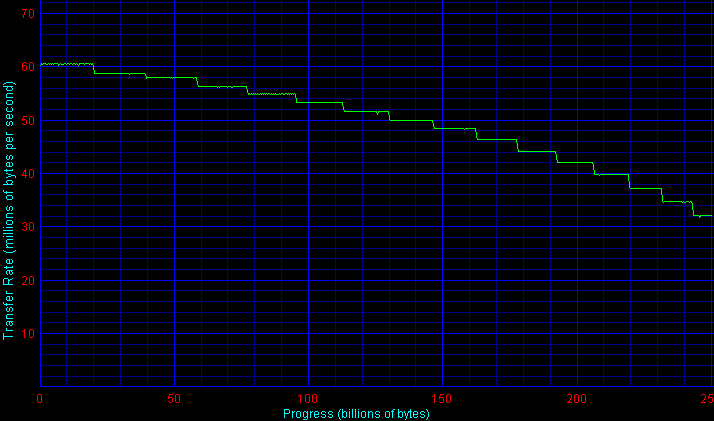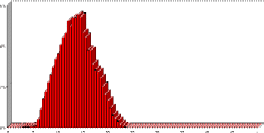|

There are actually two MaXLine series- the standard MaXLine features 5400 RPM operation while the MaXLine Plus incorporates 7200 RPM operation. The MaXLine Plus II features three 83-gigabyte platters along with the 7200 RPM spindle speed. Maxtor specifies average read seek times at 9.0 milliseconds. Though announced at the outset with both ball bearing and fluid bearing models, in practice (like the DiamondMax Plus 9), all MaxLine Plus drives feature quieter fluid dynamic bearing motors. The family comes equipped with a performance-standard 8-megabyte buffer.
What differentiates the MaXLine Plus II from a 250-gigabyte DiamondMax Plus 9? Though the firm has carefully maintained that the DiamondMax Plus 9 has been built to standards just as high as its predecessors, Maxtor claims that the MaXLine series goes above and beyond the ATA norm. It features a 1.2 million hour mean time between failure (MTBF) figure, matching the spec sported by the top SCSI drives. For those about to protest that they do not believe a drive will “run 137 years continuously” before failing, remember that MTBF is the total cumulative amount of hours a large group (500 to 1000) of the given drive should run before one of them fails. Maxtor rates the MaXLine for “24/7” operation. Many readers may remember the flack that IBM took for specifying the Deskstar 60GXP series with a “333 power-on hours per month” recommendation. Does the MaXLine’s 24/7 claim imply that other drives such as the DiamondMax Plus 9 or even the Deskstar 60GXP should not be powered on continuously? The issue remains somewhat fuzzy.

Why “II”? What happened to the MaXLine I? According to Maxtor, the 120 GB and 160 GB DiamondMax D540X drives were actually built to an elevated standard and hence, retroactively, are the first-generation MaXLine drives.
With the MaXLine, Maxtor aims to carve out a segment previously serviced by high-capacity, expensive SCSI hard disks and tape drives. Such secondary storage has traditionally been used to store or backup enormous amounts of data that users do not need to access as regularly as “first line” data. A reliable, high-capacity ATA drive ostensibly offers speed and cost advantages over traditional solutions. The MaxLine Plus II, of course, also serves as Maxtor’s premiere ATA offering to compete with drives from other manufacturers for use in mid- to high-end desktop systems as well as entry-level servers.
Low-Level ResultsFor diagnostic purposes only, StorageReview measures the following low-level parameters: Average Read Access Time– An average of 25,000 random accesses of a single sector each conducted through IPEAK SPT’s AnalyzeDisk suite. The high sample size permits a much more accurate reading than most typical benchmarks deliver and provides an excellent figure with which one may contrast the claimed access time (claimed seek time + the drive spindle speed’s average rotational latency) provided by manufacturers. WB99 Disk/Read Transfer Rate – Begin– The sequential transfer rate attained by the outermost zones in the hard disk. The figure typically represents the highest sustained transfer rate a drive delivers. WB99 Disk/Read Transfer Rate – End– The sequential transfer rate attained by the innermost zones in the hard disk. The figure typically represents the lowest sustained transfer rate a drive delivers. |
For more information, please click here.
|
Note: Scores on top are better. |
|
|||||||||||||||||||
|
|
||||||||||||||||||
The MaXLine Plus II posts an average read access time of 13.7 milliseconds, right in line with the score of the DiamondMax Plus 9. Subtracting 4.2 ms to account for the latency incurred by a 7200 RPM spindle yields a measured average random seek time of 9.5 milliseconds- half a millisecond off of Maxtor’s claim.
|
Note: Scores on top are better. |
|
|||||||||||||||||||||||||||||||||
|
|
||||||||||||||||||||||||||||||||
7Y250P0 Transfer Rate
|
|||||||||||||||||||||||||||||||||
Thanks to its high areal density, the MaXLine manages to deliver a 60 MB/sec transfer rate off of its outer zone. Inner-zone scores decay to a respectable 34.7 MB/sec.
Single-User PerformanceStorageReview uses the following tests to assess non-server use: StorageReview.com Office DriveMark 2002– A capture of 30 minutes of actual computer productivity use that exactingly recreates a typical office-style multitasking environment. The applications include: Outlook XP, Word XP, Excel XP, PowerPoint XP, Calypso (a freeware e-mail client), SecureCRT v3.3 (a telnet/SSH client), CuteFTP Pro v1.0 (an FTP/SSH client), ICQ 2000b), Palm Hotsync 4.0, Gravity 2.3 (a Usenet/newsgroups client), PaintShop Pro v7.0, Media Player v8 for the occasional MP3, and Internet Explorer 6.0. StorageReview.com High-End DriveMark 2002– A capture of VeriTest’s Content Creation Winstone 2001 suite. Applications include Adobe Photoshop v5.5, Adobe Premiere v5.1, Macromedia Director v8.0, Macromedia Dreamweaver v3.0, Netscape Navigator v4.73, and Sonic Foundry Sound Forge v4.5. Unlike typical productivity applications, high-end audio- and video- editing programs are run in a more serial and less multitasked manner. The High-End DriveMark includes significantly more sequential transfers and write (as opposed to read) operations. |
StorageReview.com Bootup DriveMark 2002– A capture of the rather unusual Windows XP bootup process. Windows XP’s boot procedure involves significantly different access patterns and queue depths than those found in other disk accesses. This test recreates Windows XP’s bootup from the initial bootstrap load all the way to initialization and loading of the following memory-resident utilities: Dimension4 (a time synchronizer), Norton Antivirus 2002 AutoProtect, Palm Hotsync v4.0, and ICQ 2000b.
StorageReview.com Gaming DriveMark 2002– A weighted average of the disk accesses featured in five popular PC games: Lionhead’s Black & White v1.1, Valve’s Half-Life: Counterstrike v1.3, Blizzard’s Diablo 2: Lord of Destruction v1.09b, Maxis’s The Sims: House Party v1.0, and Epic’s Unreal Tournament v4.36. Games, of course, are not multitasked- all five titles were run in a serial fashion featuring approximately half an hour of play time per game.
For more information, please click here.
|
Note: Scores on top are better. |
Partly due to its large capacity, the MaXLine Plus II is the first of Maxtor’s ATA drives to heave itself across the 400 I/O sec SR Office DriveMark barrier, placing itself in contention with drives from Western Digital and IBM.
Maxtor’s drive fares similarly in the High-End DriveMark with a 400 I/Os per second performance. The MaXLine turns in 373 I/Os per second in the Bootup DriveMark, a capture of Windows XP’s relatively high-queue-depth startup sequence. Both scores place the Maxtor second only to WD’s Caviar WD2500JB.
Finally, in the Gaming DriveMark, a normalized average of the performance delivered in 5 popular PC games, the MaXLine scores 527 I/Os per second, trailing the Deskstar 180GXP as well as the Caviar.
Multi-User PerformanceStorageReview uses the following tests to assess server performance: StorageReview.com File Server DriveMark 2002– A mix of synthetically-created reads and writes through IOMeter that attempts to model the heavily random access that a dedicated file server experiences. Individual tests are run under loads with 1 I/O, 4 I/Os, 16 I/Os, and 64 I/Os outstanding. The Server DriveMark is a convenient at-a-glance figure derived from the weighted average of results obtained from the four different loads. StorageReview.com Web Server DriveMark 2002– A mix of synthetically-created reads through IOMeter that attempts to model the heavily random access that a dedicated web server experiences. Individual tests are run under loads with 1 I/O, 4 I/Os, 16 I/Os, and 64 I/Os outstanding. The Server DriveMark is a convenient at-a-glance figure derived from the weighted average of results obtained from the four different loads. For more information click here. |
|
Note: Scores on top are better. |
|
|||||||||||||||||||||||||||||||||
|
|
||||||||||||||||||||||||||||||||
The MaXLine Plus II turns in scores similar to that of the DiamondMax Plus 9 in the SR Server DriveMarks. Even Seagate’s modest Barracuda ATA V manages to deliver better multi-user numbers. This is particularly unfortunate in light of the MaXLine’s explicitly stated MTBF, warranty, and power-on hours advantages over other “standard” ATA drives, attributes that otherwise make the drive particularly suitable for multi-user applications.
Legacy PerformanceeTesting Lab’s WinBench 99 Disk WinMark tests are benchmarks that attempt to measure desktop performance through a rather dated recording of high-level applications. Despite their age, the Disk WinMarks are somewhat of an industry standard. The following results serve only as a reference; SR does not factor them into final judgments and recommends that readers do the same. |
|
Note: Scores on top are better. |
|
|||||||||||||||||||||||||||||||||
|
|
||||||||||||||||||||||||||||||||
Heat and NoiseIdle Noise– The sound pressure emitted from a drive measured at a distance of 18 millimeters. The close-field measurement allows for increased resolution between drive sound pressures and eliminates interactions from outside environmental noise. Note that while the measurement is an A-weighted decibel score that weighs frequencies in proportion to human ear sensitivity, a low score does not necessarily predict whether or not a drive will exhibit a high-pitch whine that some may find intrusive. Conversely, a high score does not necessarily indicate that the drive exhibits an intrusive noise envelope. Net Drive Temperature– The highest temperature recorded from a 16-point sample of a drive’s top plate after it has been under heavy load for 80 minutes. The figures provided are net temperatures representing the difference between the measured drive temperature and ambient temperature. For more information, please click here. |
|
Note: Scores on top are better. |
|
|||||||||||||||||||||||||||||||||
|
|
||||||||||||||||||||||||||||||||
Equipped with Maxtor’s maturing fluid dynamic bearing motors, the MaXLine Plus II delivers an idle noise floor of just 41.8 dB/A despite its relatively high (three) platter count. Like recent Seagate Barracudas and IBM’s Deskstar 180GXP, one would be hard pressed to hear the MaXLine spinning away over even the quietest of power supply and CPU fans. Likewise, seeks remain fairly muffled.
After 80 minutes of intense operation, the MaXLine’s top-plate temperature hit 20.1 degrees Celsius above ambient temperature- at the high-end of the ATA spectrum. Still, it should be easy to integrate into any system that features proper ventilation.
ReliabilityThe StorageReview.com Reliability Survey aims to amalgamate individual reader experiences with various hard disks into a comprehensive warehouse of information from which meaningful results may be extracted. A multiple-layer filter sifts through collected data, silently omitting questionable results or results from questionable participants. A proprietary analysis engine then processes the qualified dataset. SR presents results to readers through a percentile ranking system. According to filtered and analyzed data collected from participating StorageReview.com readers, the |
According to filtered and analyzed data collected from participating StorageReview.com readers, a predecessor of the
Maxtor MaXLine Plus II, the
Maxtor DiamondMax Plus D740X
, is more reliable than of the other drives in the survey that meet a certain minimum floor of participation.
Note that the percentages in bold above may change as more information continues to be collected and analyzed. For more information, to input your experience with these and/or other drives, and to view comprehensive results, please visit the SR Drive Reliability Survey.
ConclusionMaxtor’s MaXLine Plus II offers decent, though not category-leading, performance. The drive’s low idle noise makes it a significant alternative to the Western Digital Caviar WD2500JB for those seeking a high-performance, high-capacity drive in a quiet computing environment. $400 is a hefty price for an ATA drive, however, and the MaXLine’s spotty distribution means that it cannot indulge in the same regular discounting and rebates that the WD2500JB enjoys. The MaXLine’s main draw, however, is its presumably superior dependability. Assessing reliability within the confines of a review is, unfortunately, beyond the abilities of even the largest, well-funded operations. Keep an eye on the SR Drive Reliability Survey for an assessment of the MaXLine Plus II’s score. Time will tell whether or not Maxtor has raised the bar on this one. |





 Amazon
Amazon